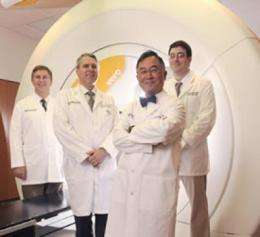Latest advance in precise radiation treatment a powerful addition -- first in the nation

UT Southwestern Medical Center has installed a new system to deliver extremely precise and individualized radiation treatment, assuring that cancer patients in the region have access to the latest advances in radiation oncology.
The VERO system, the first and only currently operating in the entire Western Hemisphere, allows UT Southwestern physicians to locate and track tumors and more precisely target radiation compared to other technologies. This helps avoid damage to healthy tissues and reduces the number of treatment sessions needed – resulting in better patient outcomes and experiences.
"Radiation oncology at UT Southwestern is unique in all of North America in terms of the breadth of our technology, research and patient care capabilities," said Dr. Hak Choy, chairman of radiation oncology at the medical center. "We are very fortunate to be able to offer many different technologies that enable us to provide the optimal approach tailored to individual patient needs."
Patients at UT Southwestern needing therapeutic radiation have access to 10 state-of-the-art machines: seven linear accelerators, two specialized stereotactic machines (CyberKnife and Gamma Knife) and the VERO – an array of options that distinguishes UT Southwestern Medical Center from other medical centers.
The newest system offers exceptional precision targeting, enabling treatment for patients for whom the risk of damage to nearby non-cancerous tissue precludes further use of standard radiotherapy. It allows doctors to monitor and adapt to each patient's anatomy and to precisely coordinate delivery of radiation with natural movements such as breathing, or in response to changes that can occur between treatments, such as tumor shrinkage or weight loss.
Because a stereotactic approach allows oncologists to deliver radiation in such a concentrated and precise manner, fewer treatment sessions are needed, Dr. Choy said.
Dr. Bruce Meyer, executive vice president for health system affairs at UT Southwestern, said: "As advances are made, we are committed to bringing the most effective therapeutic technologies to patients whose lives depend on receiving the best care from the best doctors armed with the best technology. We owe it to our patients to offer them leading-edge treatment options."
Visit the Department of Radiation Oncology or the Harold C. Simmons Cancer Center to learn more about radiation oncology at UT Southwestern, including highly individualized treatments for cancer at the region's only National Cancer Institute-designated center.















